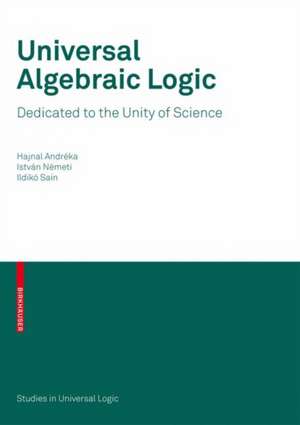Universal Algebraic Logic: Dedicated to the Unity of Science: Studies in Universal Logic
Autor Hajnal Andréka, István Németi, Ildikó Sainen Limba Engleză Paperback – 22 iul 2021
Din seria Studies in Universal Logic
-
 Preț: 454.16 lei
Preț: 454.16 lei - 17%
 Preț: 365.02 lei
Preț: 365.02 lei -
 Preț: 386.81 lei
Preț: 386.81 lei - 15%
 Preț: 653.14 lei
Preț: 653.14 lei -
 Preț: 399.29 lei
Preț: 399.29 lei - 15%
 Preț: 581.47 lei
Preț: 581.47 lei -
 Preț: 397.38 lei
Preț: 397.38 lei - 15%
 Preț: 638.43 lei
Preț: 638.43 lei - 15%
 Preț: 643.99 lei
Preț: 643.99 lei -
 Preț: 395.85 lei
Preț: 395.85 lei -
 Preț: 406.05 lei
Preț: 406.05 lei -
 Preț: 384.09 lei
Preț: 384.09 lei -
 Preț: 389.11 lei
Preț: 389.11 lei - 15%
 Preț: 532.23 lei
Preț: 532.23 lei - 24%
 Preț: 802.17 lei
Preț: 802.17 lei - 15%
 Preț: 588.18 lei
Preț: 588.18 lei - 15%
 Preț: 592.12 lei
Preț: 592.12 lei - 15%
 Preț: 697.32 lei
Preț: 697.32 lei - 18%
 Preț: 953.65 lei
Preț: 953.65 lei - 18%
 Preț: 1129.96 lei
Preț: 1129.96 lei - 15%
 Preț: 642.68 lei
Preț: 642.68 lei - 18%
 Preț: 782.10 lei
Preț: 782.10 lei - 18%
 Preț: 787.78 lei
Preț: 787.78 lei - 18%
 Preț: 1119.47 lei
Preț: 1119.47 lei
Preț: 335.51 lei
Nou
Puncte Express: 503
Preț estimativ în valută:
64.21€ • 66.78$ • 53.73£
64.21€ • 66.78$ • 53.73£
Carte nepublicată încă
Doresc să fiu notificat când acest titlu va fi disponibil:
Se trimite...
Preluare comenzi: 021 569.72.76
Specificații
ISBN-13: 9783764385057
ISBN-10: 3764385057
Pagini: 260
Ediția:1st ed. 2021
Editura: Springer
Colecția Birkhäuser
Seria Studies in Universal Logic
Locul publicării:Basel, Switzerland
ISBN-10: 3764385057
Pagini: 260
Ediția:1st ed. 2021
Editura: Springer
Colecția Birkhäuser
Seria Studies in Universal Logic
Locul publicării:Basel, Switzerland
Public țintă
ResearchCuprins
1.
Introduction.-
2.
Notation,
elementary
concepts:
2.1
Sets,
classes,
tuples,
simple
operations
on
sets.-
2.2
Binary
relations,
equivalence
relations,
functions.-
2.3 Orderings, ordinals, cardinals.- 2.4 Sequences.- 2.5 Direct product of families of sets.- 2.6 Relations of higher ranks.- 2.7 First-order logic (FOL).-
3. Basics from universal algebra: 3.1 Examples for algebras.- 3.2 Building new algebras from old ones (operations on algebras): 3.2.1 Subalgebra.-
3.2.2 Homomorphic image.- 3.2.3 Cartesian product, direct decomposition.- 3.2.4 Subdirect decomposition.- 3.2.5 Ultraproduct, reduced product.-
3.3 Variety characterization, quasi-variety characterization.- 3.4 Discriminator varieties.- 3.5 Boolean algebras.- 3.6 Boolean algebras with operators.- 4. General framework for studying logics: 4.1 Defining the framework.- 4.2 Concrete logics in the new framework.- 4.2.1 Distinguished logics.- 4.2.2 The finite variable fragment of FOL. Finite model theory.- 4.2.3 Summary.- 4.2.4 Solutions for some exercises of subsections 4.2.1 and 4.2.2.- 5. Bridge between the world of logics and the world of algebras: 5.1 Fine-tuning the framework.- 5.2 Algebraic characterizations of completeness and compactness properties.- 6. Generalizations.- 7. Further equivalence results (definability, interpolation, omitting types) 8. New kinds of logics 9. The guarded fragment and its finite variable hierarchy.- 10. Distinguished algebras of logic: 10.1 Cylindric algebras.- 10.2 Relation algebras, substitution cylindric algebras, polyadic algebras.- 10.3 Relativization. The non-square approach to ``taming logics''.- 10.4 Brief return to guarded fragment and related positive results.- 11. Applications of the algebraic results to logic (via our bridge).- 12. Connections with set theory and foundational thinking.- 13. Connections with abstract model theory.- 14. Extending the bridge to including logic of spacetime, connections with relativity.- 15. On the problems in the books Henkin-Monk-Tarski: Cylindric Algebras Parts I,II and Henkin-Monk-Tarski-Andreka-Nemeti.- Some further problems.
2.3 Orderings, ordinals, cardinals.- 2.4 Sequences.- 2.5 Direct product of families of sets.- 2.6 Relations of higher ranks.- 2.7 First-order logic (FOL).-
3. Basics from universal algebra: 3.1 Examples for algebras.- 3.2 Building new algebras from old ones (operations on algebras): 3.2.1 Subalgebra.-
3.2.2 Homomorphic image.- 3.2.3 Cartesian product, direct decomposition.- 3.2.4 Subdirect decomposition.- 3.2.5 Ultraproduct, reduced product.-
3.3 Variety characterization, quasi-variety characterization.- 3.4 Discriminator varieties.- 3.5 Boolean algebras.- 3.6 Boolean algebras with operators.- 4. General framework for studying logics: 4.1 Defining the framework.- 4.2 Concrete logics in the new framework.- 4.2.1 Distinguished logics.- 4.2.2 The finite variable fragment of FOL. Finite model theory.- 4.2.3 Summary.- 4.2.4 Solutions for some exercises of subsections 4.2.1 and 4.2.2.- 5. Bridge between the world of logics and the world of algebras: 5.1 Fine-tuning the framework.- 5.2 Algebraic characterizations of completeness and compactness properties.- 6. Generalizations.- 7. Further equivalence results (definability, interpolation, omitting types) 8. New kinds of logics 9. The guarded fragment and its finite variable hierarchy.- 10. Distinguished algebras of logic: 10.1 Cylindric algebras.- 10.2 Relation algebras, substitution cylindric algebras, polyadic algebras.- 10.3 Relativization. The non-square approach to ``taming logics''.- 10.4 Brief return to guarded fragment and related positive results.- 11. Applications of the algebraic results to logic (via our bridge).- 12. Connections with set theory and foundational thinking.- 13. Connections with abstract model theory.- 14. Extending the bridge to including logic of spacetime, connections with relativity.- 15. On the problems in the books Henkin-Monk-Tarski: Cylindric Algebras Parts I,II and Henkin-Monk-Tarski-Andreka-Nemeti.- Some further problems.
Caracteristici
Introduction
to
algebraic
basicsConnects
logic
with
algebra
